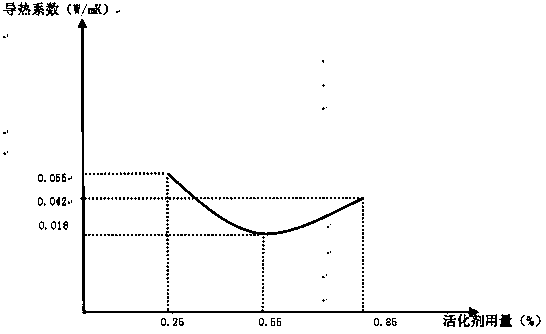Method for improving thermal insulation performance of kapok fiber
A technology of kapok fiber and thermal insulation performance, which is applied in fiber processing, plant fiber, textile material processing and other directions to achieve the effects of expanding the scope of application, reducing costs, and high specific surface area
- Summary
- Abstract
- Description
- Claims
- Application Information
AI Technical Summary
Problems solved by technology
Method used
Image
Examples
Embodiment 1
[0021] A method for improving the thermal insulation performance of kapok fiber, comprising preparation of activator, pretreatment of kapok fiber, dipping process, washing and air-drying, and spinning;
[0022] Specifically, the following process steps are included:
[0023] The preparation method of the activator: Weigh 75 grams of silicon dioxide and 110 grams of barium sulfate powder, place them in 300 milliliters of hydrochloric acid solution, stir evenly, leave to stand for acidification for 3 hours, filter, and place the product in an oven at 70°C for drying After 10 hours, the dry powder obtained was placed in a crucible, placed in a tube furnace preheated at 220°C, and nitrogen gas was introduced for protection. The nitrogen flow rate was 0.8 liters / min, and the temperature was raised to 600°C at a rate of 6.5°C / min. After 1 hour, cool naturally with the furnace to 25°C, take out the product and transfer it to hexamethyldisilazanol solution, the ratio of material to li...
Embodiment 2
[0028] A method for improving the thermal insulation performance of kapok fiber, comprising preparation of activator, pretreatment of kapok fiber, dipping process, washing and air-drying, and spinning;
[0029] Specifically, the following process steps are included:
[0030]The preparation method of the activator: Weigh 78 grams of silicon dioxide and 115 grams of barium sulfate powder, place them in 320 milliliters of hydrochloric acid solution, stir evenly, leave to stand for acidification for 3.5 hours, filter, and place the product in an oven at 80°C for drying After 12 hours, the dry powder obtained was placed in a crucible, placed in a tube furnace preheated at 225°C, and nitrogen was introduced for protection. The nitrogen flow rate was 0.9 liters / min, and the temperature was raised to 620°C at a rate of 6.8°C / min. After 1.5 hours, cool naturally with the furnace to 28°C, take out the product and transfer it to hexamethyldisilazanol solution, the ratio of material to li...
Embodiment 3
[0034] A method for improving the thermal insulation performance of kapok fiber, comprising preparation of activator, pretreatment of kapok fiber, dipping process, washing and air-drying, and spinning;
[0035] Specifically, the following process steps are included:
[0036] The preparation method of the activator: Weigh 80 grams of silicon dioxide and 120 grams of barium sulfate powder, place them in 340 milliliters of hydrochloric acid solution, stir evenly, leave to acidify for 4 hours, filter, and place the product in an oven at 90°C for drying After 15 hours, the dry powder obtained was placed in a crucible, placed in a tube furnace preheated at 230°C, and nitrogen gas was introduced for protection. The nitrogen flow rate was 1.0 liter / min, and the temperature was raised to 650°C at a rate of 7.0°C / min. After 2 hours, cool naturally with the furnace to 30°C, take out the product and transfer it to the hexamethyldisilazanol solution, the ratio of material to liquid is 1:16...
PUM
| Property | Measurement | Unit |
|---|---|---|
| Particle size | aaaaa | aaaaa |
Abstract
Description
Claims
Application Information
 Login to View More
Login to View More - R&D
- Intellectual Property
- Life Sciences
- Materials
- Tech Scout
- Unparalleled Data Quality
- Higher Quality Content
- 60% Fewer Hallucinations
Browse by: Latest US Patents, China's latest patents, Technical Efficacy Thesaurus, Application Domain, Technology Topic, Popular Technical Reports.
© 2025 PatSnap. All rights reserved.Legal|Privacy policy|Modern Slavery Act Transparency Statement|Sitemap|About US| Contact US: help@patsnap.com

